Cal’s been in touch with something he’s found for cleaning model train track:
“Al:
Here is a new tip I found out about the other day. I tried it and it works WONDERS!!!
First. I used the “QD contact cleaner” on my engines and locomotives. I spray a light rag or paper towel with this stuff. Then I put the towel on the track and run my engine or loco over the wet part at full speed holding onto it so it doesn’t run off on me.
I run it back and forth till the wheels are clean. You would not believe the gunk and buildup that comes off the wheels. Then I turned the loco around and did the same thing for the rear wheels.
I then did this same thing to each and every car. The buildup that came off the wheels was amazing.
Then I took a rag and rubbed all the track down with this contact cleaner.
Second, I then fashioned a block with 2 scraps of wood and a piece of roadbed cork and hot glued them to make an applicator.
I took the “2-26 multi purpose precision lubricant” and sprayed it onto the cork part of my block I made. I then rubbed it along the entire track system. The rails shined up like a new penny.
Now my trains crawl at low speeds and run MUCH MUCH better and the best part is the guy who told me about this system hasn’t cleaned his track in over a year and it still runs like a top.
This system is supposed to last MONTHS before you have to clean again! I cannot believe how much better my trains run.
I used to use goof off or goo gone, but this is much better.
To clean my engines I used to use rubbing alcohol on the wheels but it just took off surface dirt. I’ve noticed by using the QD contact cleaner it took off all the gunk and build up from over the years.
I am very very happy with the results.
Here are pictures of the product I bought in a hardware store, the block I made and an example of the rag with dirty track stains on it so you can see how it cleans.
Best of luck to all fellow Model railroaders with your track cleaning!!!
I found my system I will be using from now on!!!
Cal from Oregon USA”
Cleaning model train track is something that comes up a lot on the blog – it really can cause problems.
A big thanks to Cal. It reminded me of Bob’s post: Track cleaner.
And Kim’s: Homemade model train track cleaner.
Now on to Ben.
“Hi Al!
My name is Ben and I’ve enjoyed your emails for a few months.
Thought I would share some pics of the switching layout I’m building. It’s 8×4 and HO scale. I haven’t had a layout in 20 years. I’ve always wanted a switching layout because that’s my favorite thing about trains, switching yards and industries.
Keep the great emails going!
Ben”
“Hi Alastair
Here is a little tip for all of the model railway fans out there.
Before throwing out that old mobile phone, modem, Christmas tree lights etc or whatever. Keep the power supply back (unless its faulty of course) as many of these are rated at 12 volts DC and most are also rated at about 500ma (half an amp) to 1 amp sometimes you might find them rated at 1500ma.
these are great for powering station or building lighting when using LED lights. The centre pin on a female jack is generally the positive and may be marked on the wire with a tracer marking, making it easier to cut of the female jack and identify the positive wire.
I have several of these around my small Lionel O gauge layout. works a treat. My Modified Hobo Hotel with all the electronics I added is powered from an old Power adaptor rated at 1 amp. (shown)
keep up the good work with the site
Regards
Ernie
Essex UK”
“Alastair–always look forward to your daily e-mails with questions and answers from other modelers…so when I ran into a problem I figured that someone in your group might have the answer to a problem I’m currently having.
Here’s the situation: I’m adding a 72×76″ extension to the existing Damnit RR using Atlas snap track and flex track. There is only 2 ways to connect it to the existing tracks and they are colored BLACK in the pictures and can’t be moved. The new section must have a 22-24” radius in order to take existing cars and there needs to be sidings to park the cars when not in use, yet not block the whole line. In addition to providing storage space, the extension must create a way to reverse a complete train in both directions–i.e. eastbound has option to become westbound and vice versa.
The first picture shows the complete layout with the extension with a proposed solution, the second is just the extension itself.
(all pics are clickable)
As you can see, the proposed ladder portion in light green doesn’t meet the requirements and involves a lot of back and forth shuffling of a single car at a time. That doesn’t work because one of the cars is the SP triple unit (coffee shop, diner, kitchen–28″ long) and can’t be unhooked. The same applies to the rest of the SP units which are double units of 19″ long each. They too can’t be uncoupled.
Any ideas your members can provide would be greatly appreciated. I’ve been working on this for weeks and am at a complete loss.
Thanks so much
Terry”
A big thanks to everyone for today’s post, especially to Cal for sharing his way way cleaning model train track.
And who can help Terry? Sometimes we all get problems that vex that the most seasoned modeler.
That’s all for today folks.
Please do keep ’em coming.
And if today is the day you get started on your layout, the Beginner’s Guide is here.
Best
Al
PS Latest ebay cheat sheet is here.
PPS More HO scale train layouts here if that’s your thing.

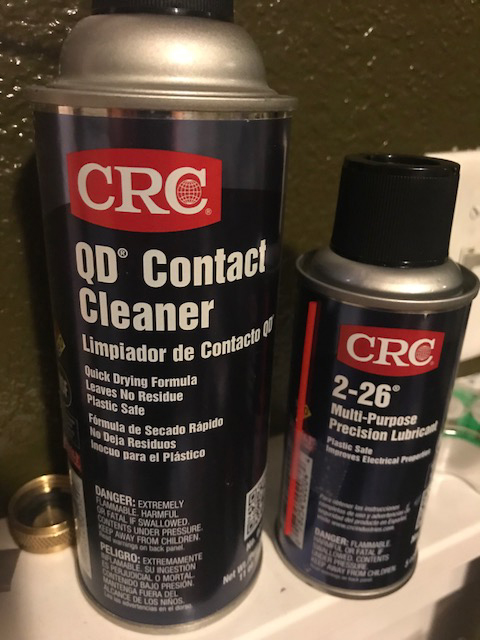
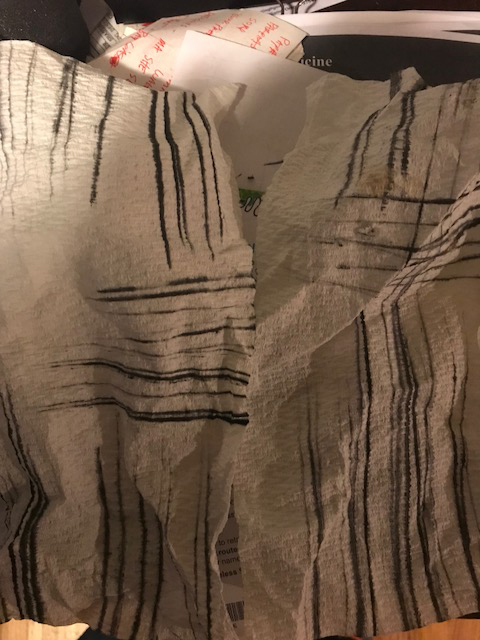
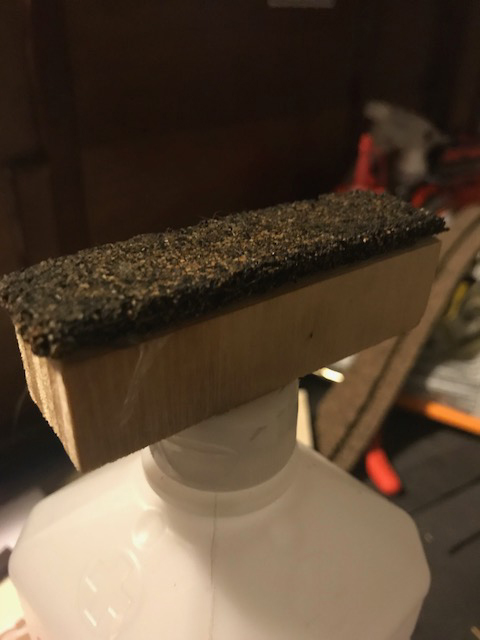
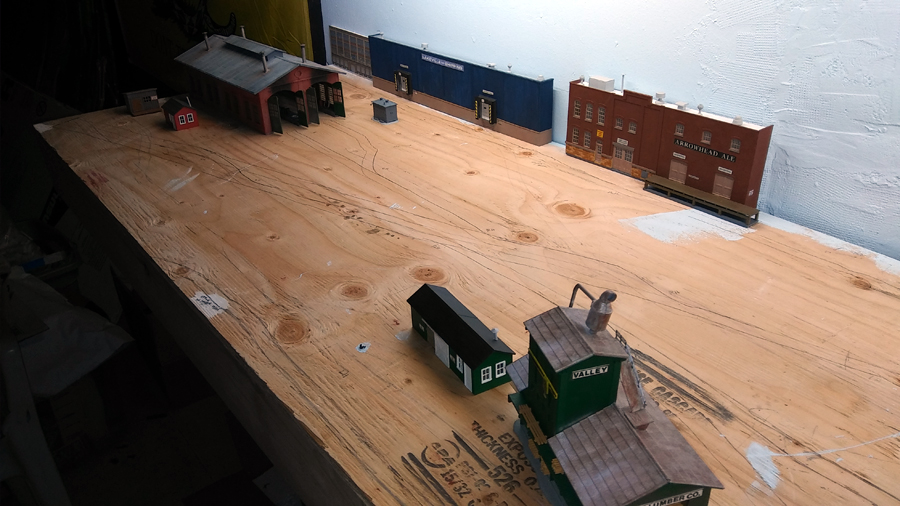
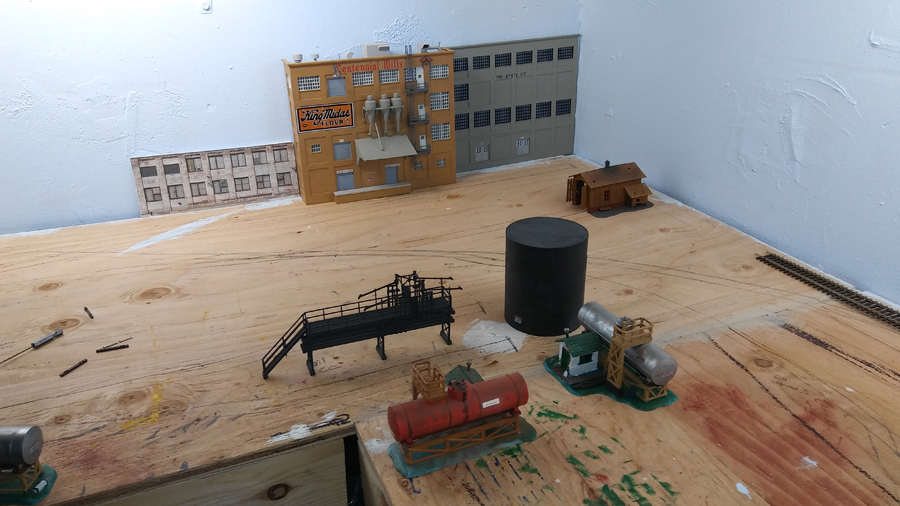
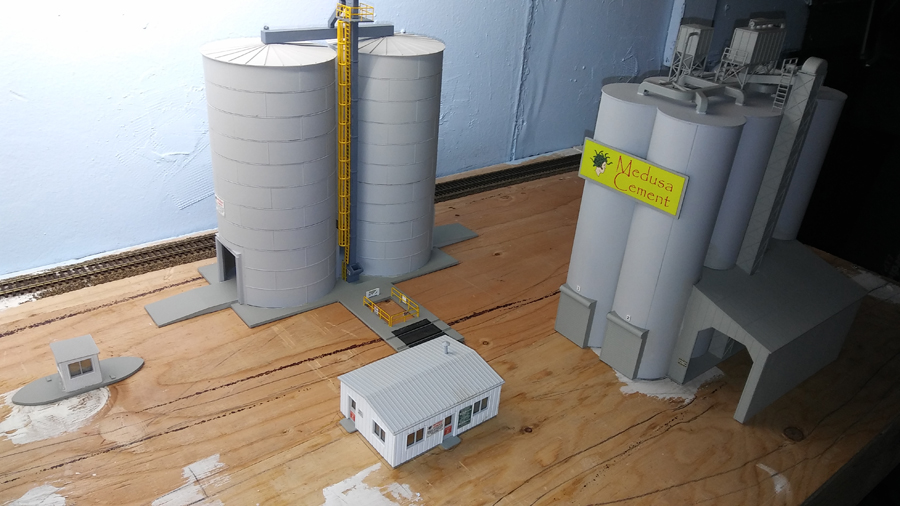
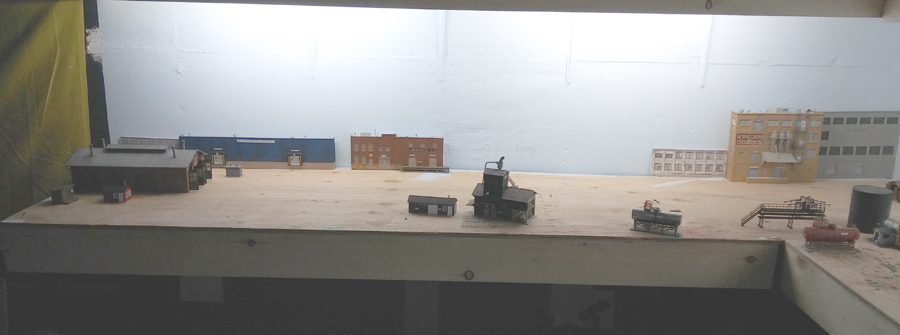
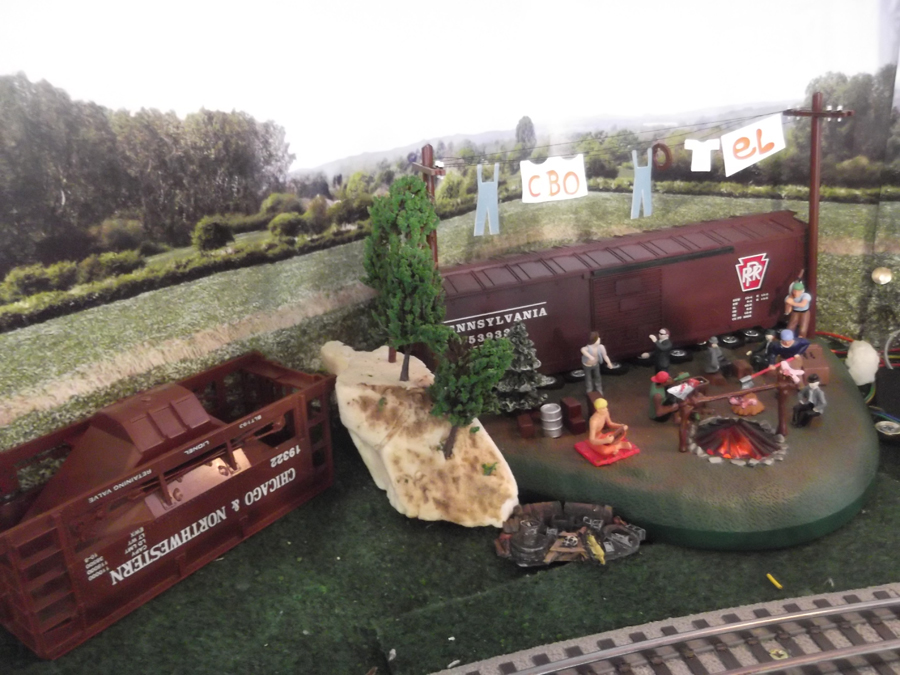
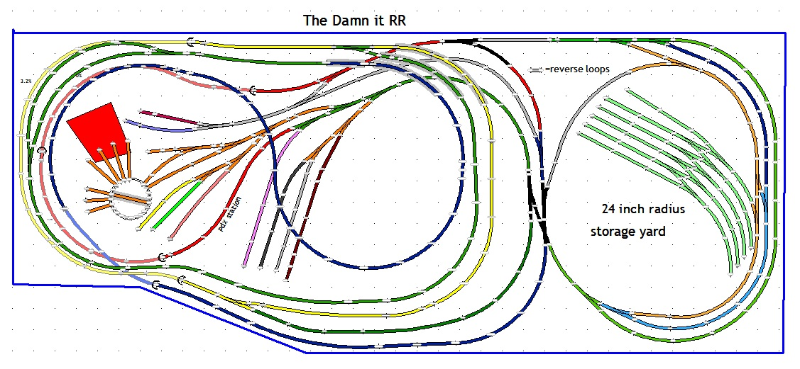
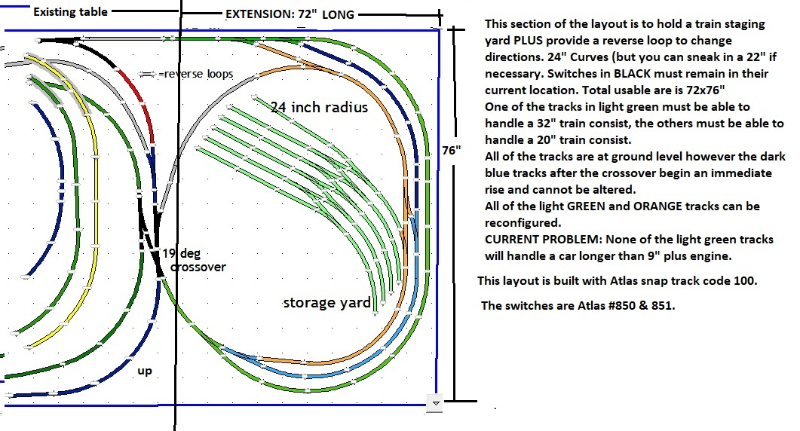

The other problem with the ‘ladder’ is that in order to get the train at the bottom of the ladder out, you need to empty all the other ‘rungs’ of the ladder first…..
Are there any suitable curved points you can use to take the sidings directly off the oval (even if this means doing away with the brown loop)?
To cover Terry’s problem, he should be able to replace the curve coloured orange with a ladder of 3 Peco left hand curved turnouts of the Set Track variety.
This would give him 3 yard tracks which if curved should maximise the holding capacity of the staging yard but more importantly be a useful length.
Hope this helps
something I’ve just started to do is use a 9 volt power adapter to run a Z scale engine on a large briefcase portable layout , I’ve wired it to a speed control making it into a mini transformer , and I like it better then the Marklin 9 volt battery controller
Lose the blue loop on the extension. Connect the grey/orange loop into the green outer loop half way down the right side. You now have a straight section in the outer loop where the point at the lower exit of the blue loop used to be. Insert a turnout into the blue line at the lower right corner of the existing layout, just to the left of where it says ‘up’ and connect this onto the extension with a flat crossing of the green loop, then immediately divide this into say three sidings running diagonally up toward the top right corner of the extension, should be room for three car sections I should think, all accessible with a single shunt. OK, you might have to make a bespoke flat crossing with copper clad Paxolin strip and rail, but it’s not difficult with tracklaying gauges. Iain Rice did a very good book on making track.
Rod
Terry, consider the enterance to your storage tracks be a drop down to hidden tracks below, this allows the full 76″ as a ladder track, and even switches on the tail end. If this looks promising, even have the tracks “drive through” and come back up on the other end rejoining the loops again. This is the approach I’m planning on my railroad, except the storage tracks will be under a mountain range accessable from behind the layout.
I think the use of the CRC Q- day contact cleaner over alcohol is a great idea.
I must be missing something on the use of a lubricant on the track as it appears that this would cause loss of traction. Please commit
Terry
Put a helix on the new extension. You can then put a long narrow staging area to hold your long cars as well as many other cars.
I use choke and carb cleaner on my Lionel track. Sane method – just spray it on a rag and wipe the track. very effective.
See I KNEW the readers of this forum would have some better ideas. Thanks to all for the suggestions and I’ll let you know how the final project comes out.
Terry
To begin with I absolutely LOVE your existing layout! You already have a diuble return built into it. Consider simplifying your extension. The crossover and related switches in the middle of the right side are the cause of all your trouble. The new loop around tracks take up all the space you need for the yard.
Consider putting a switch at the lower right on your present layout so train goes directly East and a similar swith at the upper rigt to onnect to the new pRt. Then you can build a much longer yard ladder with in/out tracks to build and store nice sized trains that come from somewher and go somewhere. The yard tracks can be curved to allow lots of cars to be stored.
Your existing yard plan ends up being a terminal yard not a through yard which would be more fun ti operate I think.
My own pike is much similar to yours and resides in the garage higed up to the wall and I am planning a big permanent terminal yard extension to store trains in the shelving unit adjacent to it shen nit in operation. I too LOVE lots of switches abd running tracks but compromise was necessary to make it all wirk in one level.
Anyway, just some thoughts for consideration, happy railroading Terry
Regards, Larry
Terry. Sorry about the spelling, fingers are too big to type on cel phone easily.
Larry
The Damnit Railroad – I love it! Good luck with your question.
No sandpaper, no fancy cleaning pads, just one q tip.
go to an auto parts store and get a quart of ATF about $3 don’t believe you can buy less
use the q tip put the ATF on about one inch of your track only used it once
I have a double engine pulling seven heavy duty passenger cars up a 2 to 3 degree grade
have been using this about two years engines start smooth and run great
A Note of Caution
when using cleaner’s on your train engines ,
be careful that you don’t get any on the plastic parts and paint as some of them will damage or discolor the paint
had that happen with one engine after using a penetrating oil to free up the gears and motor , a over spray came in contact with the plastic body and took some oof the finish off of the engine , have been told that rubbing alcohol works well for cleaning the penetrating oils with out causing a problem on the plastic train body
For some strange reason the lubricant does not affect the performance of the engine as far as slippage on the track on grades. I was told that the lubricant merely coats the small imperfections in the rails and keeps them from getting dirty. I have noticed a film on the tracks when I rub my finger over them, but the trains run great.
On another note, I too have heard that automatic transmission fluid works great too. As described above, you put some on a QTip or cotton swab and rub it on both tracks about an inch long at various locations on your layout. This I heard works wonders as well and you never need to use a track rubber again. I’m going to try that next time to see how it works. But I don’t have to worry about cleaning my track for at least 6 months from now. I’ll keep you posted. Oh and yes, you do need to be careful when using solvents on any plastic parts. I could not believe the amount of gunk I got off my engines wheels as well as the car wheels!!
You can make a normal yard by coming off the blue line at the “UP” lettering and cross the green line at a 60 to 90 degree angle. Then make a ladder after crossing. four tracks will give as much storage as your drawing an save you 6 switches. Atlas makes a stubby 90 that should work. You may have to trim the length of one of the green tracks if you can’t buy a shorter track.
I noticed you currently don’t have reversing loops. Remember they must have isolated sections with reversing switches.
Terry, I would suggest removing the right turnout and center reverse loop track. Replace the 19* crossover with a double slip switch and run a connecting track between the blue track and the green extension loop at bottom of your diagram. This will create a large Y for turning trains. This should give you more room for long storage tracks using curved turnouts. Also, you might look into using the new Micro Engineering Ladder Track System turnouts to get tighter spacing in you storage yard. Best of luck with your plans and Happy New Year to everyone! Tim
have you thought of going under the existing layout? a double track spiral or ramp to a storage facility built to house what ever length of train ?
Can we purchase Q D Contact cleaner in the U K,
Thanks Ian
To repeat and emphasize some of the warnings above – be careful with unusual track cleaning chemicals. Some will dissolve the foam base many of us use. Test any chemicals on scraps of foam, plastic, and even adhesives you may use to glue down ballast, etc. Some chemicals have made “caves” and “hide-outs” in my hills and mountains. As a general precaution, apply track cleaners to an applicator (cotton swab, cloth, cork) and do not apply directly to your layout. Be careful using sprays – as noted above, overspray can cause problems on plastic cars & engines.
Still in Training
Carl in Kansas
The CRC Cleaner can says “plastic safe”. I have used this type of electrical cleaner for years and never had problem with plastic, but I have not used it on painted plastic.
great tip and thanks for the photos keep sharing.
Thanks, Cal. I’m a little confused about how you apply the contact cleaner to the loco wheels. It seems from your tip that you run the loco over the cloth stretched across the track. The wheels of the older Lionel (AC) locos will roll by pushing the loco on the track, but newer ones (DC) will not. So, do you power the loco onto the cloth? If so, how does that work? Doesn’t the cloth block the current to the pick-ups, thus stopping the loco? Or de-railing it? How about the locos with rubber traction tires?
Allen
Aiken, SC, USA
I’m am American Flyer collector and I will some day start to build my Railroad.
where did you get the buildings, etc. from?
Never saw you newsletter before. I did get some great ideas.
please put me on your mailing list.
Thanks,
Barry
Cal,
Regarding the applicator, the picture seems to differ from your explanation. It looks more like scrubbing material, (like Scotch-Brite), than cork. Have I missed something here?
Great cleaning process. Can’t wait to try it on my American Flyer layout!
Dennis, from Vashon Is., WA
Hi Cal, I’m glad you found something to help with the ungodly chore of wheel cleaning. I’ve always used Goof Off regular and, have found it works great. Of course stay in a well ventilated area or you could get spacy from the fumes.
Cal…..thanks for the tip. I use Goo Gone…… but I will try this.
Terry,
In my limited experience I would suggest placing a curved turnout at the end of the orange line curve running onto the backstretch. This curved turnout would give you a parallel line that you can ladder off of. The biggest obstacle in my mind is the grey line; if you can depress the new yard and maybe elevate the gray line you can have the gray line pass over the yard between the orange line and main layout switch.
Ben,
Glad to see you’re getting back into the hobby. I’m somewhat of a rookie with a 4 X 8 HO scales layout. I’m trying to model rural/farming scenes.
I looked at your pictures and was wondering where you got the ‘drive thru’ dual grain bins? I have been looking for something like this for quite a while but without any luck. I have the perfect spot on my HO scale layout.
Thanks.
Glenn Beebe
Ohio, USA
Ben,
Nice start on your layout! It looks bigger than 4×8 feet with the L-shaped extension. Looks like you’ve had fun building all those Walthers kits. Send us more photos when you get some track laid.
Terry,
Interesting layout problem. I would suggest adding a right-hand turnout in the yellow (upper level) line just where it starts its curve at the top of the layout (below the Damn It RR label.) Put your staging yard on an upper level above the new reversing loop tracks (which could be relegated to a tunnel or deep cuts around a central plateau for the staging yard.) This would give you most of the new addition for staging without having to try fitting it between the reverse loop tracks. You could also add a turnout at the lower part of that same yellow line curve to give you a double-ended siding from which to feed your staging yard ladder tracks. Hope this helps with your dilemma.
Cal & Ernie,
Thanks for sending us your great tips. I will have to try them both.
Wow that great workmanship? I hope mine comes out that good.
Cal,
I have seen CRC 2-26 used on a large O scale layout.
What scale is your layout?
I think it may be a problem for traction on grades with smaller scales like HO which have less weight in the engines.
Thanks, to everyone for the great tips! Readings Al’s blog digest every day is a great learning experience for me.
Terry, You’ve received several great suggestions. I hope you’ll follow-up with a post on what you chose to do. I’ll be eager to see that!
Thanks, Al, for all you do with this blog, the website, your manual, and the printed buildings/structures! My grandson gets such a hoot watching John’s videos you provide with the how-tos – and we practice. 😉
Jerry – Indiana, USA
Terry
You might consider a slight variation to your extension plan by moving your loop tracks further left of the right hand side of your plan. This will allow room for your terminal storage tracks to the outside.
The constriction would be eliminated, storage tracks would be longer to hold 4 or 5 cars, so you would need fewer of them and really reduce your switching. One of these could conceivably be a through track.
Good luck!
Larry
Terry, If I have interpreted your layout you will be creating a reversing loop. No problem as Don says above, but it will require additional attention to the wiring both for DCC and DC.
Best wishes
from Down Under
Andrew in Oz.